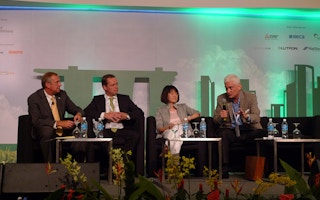Adopting new technologies to make buildings energy efficient can be a daunting financial decision for building owners and developers, so what financing solutions are out there that can assist with the transition?
According to a global survey conducted by Johnson Controls which saw 2,882 respondents from 36 countries, building decision-makers consider energy management a priority, and the results demonstrates “significant green building goals across all economies,” said Mr. Clay Nesler, Vice President, Global Energy and Sustainability for Building Efficiency, Johnson Controls, Inc.
Titled the 2010 Energy Efficiency Indicator, the survey also showed that limited internal capital is the greatest barrier to the adoption of green technologies. Other factors include insufficient payback or return on investment, and uncertainty of savings.
Facilitating session 3 of the WGBC International Congress 2010, Mr. Nesler was among the speakers who showcased innovative financing solutions in tackling the issue of limited internal capital.
The others include Mr. Harry Verhaar, Senior Director of Energy & Climate Change, Philips Lighting Global, Ms. Yuko Nishida, Planner of Urban and Global Environment Division, Bureau of Environment, Tokyo Metropolitan Government and Mr. Roger Platt, Senior Vice President of Global Policy & Law, USGBC.
Mr. Verhaar shared that because 50 per cent of the world’s population now live in cities, and with lighting being 19 per cent of global electricity consumption, it is logical to look at energy efficient solutions. “Energy efficient lighting is one of the most attractive ways to cut cost and save money,” he said.
Citing Lebanon as an example, Mr. Verhaar said that the country could save themselves one power plant if everybody switched to energy efficient lighting, adding that the “money could be spent on things that really matter” such as on health and education.
Wishing to make the switch to energy efficiency a less painful option, Philips has put together two financing plans for building owners with budget limitations - “Philips Lighting Payment Program” and “Philips Lighting Extended Payment Program”, both which require no initial investment costs, and can be paid up within 3 years.
Another innovative solution presented was Tokyo Metropolitan Government’s Cap and Trade Policy, the world’s first urban cap and trade program to cover office buildings, and covers Tokyo Prefecture’s industries, commercial buildings and large office buildings including the prime minister’s office nor parliament buildings. This was introduced to address Tokyo’s emissions reduction target of 25 per cent below 2000 levels by 2020.
Faced with strong opposition from business groups initially, the emissions trade scheme (ETS) was finally accepted “after an open discussion, and small meetings and negotiations,” said Ms. Nishida. In June 2008, it was introduced, and the mandatory cap imposed on facilities till 2014 is 6 per cent. Companies are allowed to buy and sell carbon emission credits from each other.
According to Price WaterHouse Coopers in 2008, Greater Tokyo’s regional economy is worth US$1.5 trillion, making it the world’s biggest metropolitan community. Therefore with the implementation of the ETS, they are convinced that this would not only have a big effect to Japan but also “make a major contribution to the world”.
In addition, other initiatives in Tokyo include renovating and retrofitting projects to include highly efficient air-conditioning and lighting systems, and the installation of renewable energy fittings, such as photovoltaic technology.
On the topic of financing, Mr. Platt said that there has been no revolutionary change and brand new ideas, therefore there is still resistance, because while it is an exciting paradigm that people are able to pay nothing upfront in the instance of Philips, people are not ready to buy into it because “the devil is in the details”.
He later said that building owners face some issues such as finding the money to taper the financing of projects, especially when “your lease agreement with the tenant may not allow you the money that you get from the tenant, to make long term improvements to the building because your tenant may not benefit from that… under the lease agreement”.
He further elaborated that whenever you have to make major retrofits to building, the lender will want to have a lien on the building, which is typically not what the owner of a big building such as the Empire State Building would want.
A Property Assessed Clean Energy (PACE) finance scheme was put in place in the US to work around these issues, where it would be possible to attract money from larger financial companies, that are repaid by borrowers through their property tax bills, however lenders cannot apply a lien against the assets of the building.
While this was unfortunately shut down by residential lenders for the residential sector, because its members found the terms unfavourable for their industry, there are still opportunities with commercial buildings. Another plus point to this scheme is when the building owners transitions, the obligations will transfer to the owners.
Towards the end of his presentation, Mr. Platt said, “When governments lead by example, they can build by economies of scale,” adding that the value of a great standard is that it really is a standard of leadership.
Eco-Business.com’s coverage of the WGBC International Congress in Singapore is thanks to the support of City Developments Ltd (CDL).








